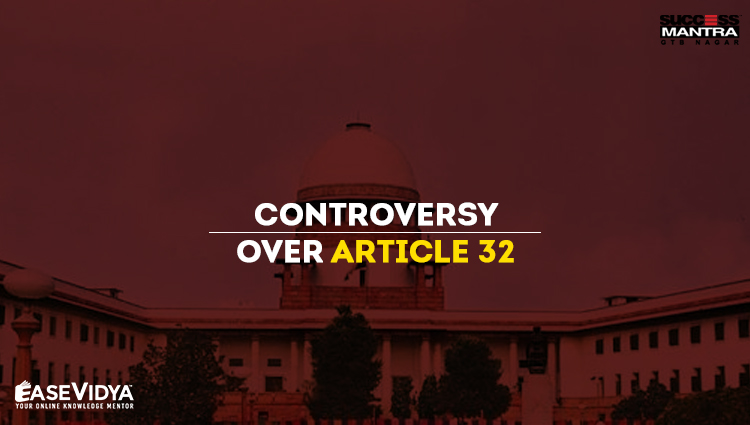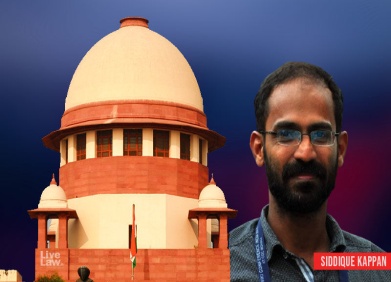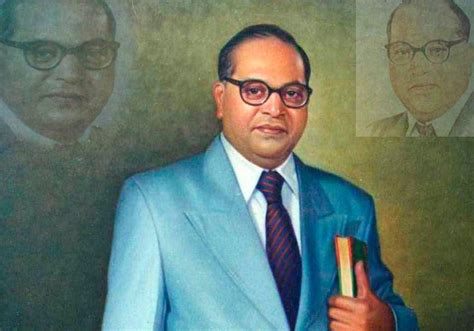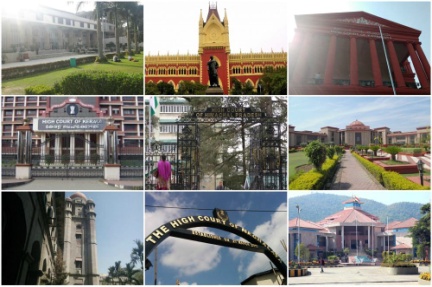
CONTROVERSY OVER ARTICLE 32 OF INDIAN CONSTITUTION
CONTROVERSY OVER ARTICLE 32 OF INDIAN CONSTITUTION

Recently, the Chief Justice of India (CJI), during a hearing of a plea, said that the court is trying to discourage petitions filed under Article 32. CJI noted that there is a spate of Article 32 petitions and reiterated that the High Court can also uphold fundamental rights (under article 226). The top court said this Monday while hearing the habeas corpus plea filed under Article 32 by the Kerala Union of Working Journalists for the release of journalist Siddique Kappan. Kerala-based Kappan was arrested on 5 October when he was on his way to Hathras to report on the alleged gang rape and murder of a 20-year-old Dalit woman. The police had initially arrested Kappan, along with three others, under Section 151 of the Code of Criminal Procedure (CrPC) on the suspicion that they may commit some cognizable offence. Later, they were also booked on charges of sedition and sections of the Unlawful Activities Prevention Act (UAPA).
SCOPE OF ARTICLE 32 OF IC

Article 32 falls under Part III of the Indian Constitution (IC) that includes the fundamental rights of individuals. It allows an individual to approach the Supreme Court if she or he believes that her or his fundamental rights have been violated or they need to be enforced. Dr B.R. Ambedkar had once said, “If I was asked to name any particular article in this Constitution as the most important — an article without which this Constitution would be a nullity — I could not refer to any other article except this one (Article 32). It is the very soul of the Constitution and the very heart of it.”
The SC has power to issue directions or orders or writs for the enforcement of any of the fundamental rights. The writs issued may include habeas corpus, mandamus, prohibition, certiorari and quo-warranto. The right to move the SC shall not be suspended except as otherwise provided for by the Constitution. Thus, the Constitution provides that the President can suspend the right to move any court for the enforcement of the fundamental rights during a National emergency (Article 359).
In case of the enforcement of Fundamental Rights, the jurisdiction of the SC is original but not exclusive. It is concurrent with the jurisdiction of the high court under Article 226. Original, because an aggrieved citizen can directly go to the SC, not necessarily by way of appeal. Concurrent means when the Fundamental Rights of a citizen are violated, the aggrieved party has the option of moving either the high court or the Supreme Court directly. Since the right guaranteed by Article 32 (i.e., the right to move the SC where a fundamental right is infringed) is in itself a fundamental right, the availability of alternate remedy is no bar to relief under Article 32. However, the SC has ruled that where relief through the high court is available under Article 226, the aggrieved party should first move the high court.
RELATED JUDGEMENTS AND CASE LAWS
• In a judgment in the L. Chandra Kumar vs Union of India and Others case, a bench of seven judges had unequivocally declared that Article 32 was an integral and essential feature of the Constitution and constituted its basic structure.
• Similarly, in a judgment in the S.P Sampath Kumar vs Union of India case, it was observed that the Supreme Court’s powers under Article 32 formed part of the basic structure of the Constitution.
• During the 1975 Emergency, a five-judge bench of the Supreme Court, in the ADM Jabalpur vs Shivakant Shukla case, had ruled that the right to constitutional remedies under Article 32 would remain suspended during a national emergency. People were unable to seek recourse to enforcement of their fundamental rights.
• After the Janata Party won the 1977 general elections, it passed the 44th Amendment to “restore the Constitution to the condition it was in before the Emergency”. The amendment stated that any change to the basic structure of the Constitution could only be made if it was approved by a majority of votes in a referendum where at least 51 percent of the electorate participated.
• It also said that an emergency could only be proclaimed after a prime minister and her/his cabinet given a written advice to the president. “Unlike in 1975, it is no longer possible for the prime minister to unilaterally take a decision about the proclamation of an emergency without any written explanation,” the amendment said.
• The 44th Amendment also stated that according to Article 359, the president could issue orders suspending the right to move any court for the enforcement of fundamental rights, under Article 32, during a national emergency, with the exception of Article 20 (deals with protection of certain rights in case of conviction for offences) and Article 21 (protection of life and personal liberty).
COUNTER ARGUMENT (ARTICLE 226 OF IC)

• Even as the SC underlines the powers of the high courts, it has in the past transferred cases to itself from the high courts. Most recently, the SC transferred the case involving land use for the national capital’s Central Vista project to itself from the Delhi High Court. Incidentally, the petitioners had not sought such a transfer. When such transfers are made, the petitioners lose a stage of appeal that would otherwise have been available had the high courts heard and decided the case. Recently, the SC also conveyed its concerns that in many matters involving personal liberty, the High Courts are not exercising their jurisdiction as constitutional courts.
• Article 226 of the Constitution empowers a high court to issue writs including habeas corpus, mandamus, certiorari, prohibition and quo warranto for the enforcement of the fundamental rights of the citizens and for any other purpose. The phrase ‘for any other purpose’ refers to the enforcement of an ordinary legal right. This implies that the writ jurisdiction of the high court is wider than that of the SC. This is because the SC can issue writs only for the enforcement of fundamental rights and not for any other purpose, that is, it does not extend to a case where the breach of an ordinary legal right is alleged.
• The high court can issue writs to any person, authority and government not only within its territorial jurisdiction but also outside its territorial jurisdiction if the cause of action arises within its territorial jurisdiction.
• Article 32 & PIL under it: The ambit of Article 32 was further broadened when individuals not having any locus standi in cases were allowed to file PILs under it before the Supreme Court. A PIL can be filed by any person under Article 32, not solely for her or his personal gain or pecuniary benefit but for the public benefit at large. The rationale behind this was that there could be situations when a victim may not have the necessary resources to move court if her or his rights were breached. In such cases, either the top court would take cognizance of the matter and precede suo motu or hear a petition on behalf of an individual for public benefit. The Supreme Court has accepted letters and even postcards as PILs over the years.
QUESTIONS (1-5)
Q.1 Under which of the following Articles of the Constitution of India, is the power to issue writs for the enforcement of the Fundamental Rights vested in the Supreme Court and the High Courts?
A. Article 32 only
B. Article 226 only
C. Article 32 and Article 226 both: ANSWER
D. Neither Article 32 nor Article 226
Q.2 Which of the following Articles of the Indian Constitution is considered as the 'Heart and Soul of the Indian Constitution by Dr. BR Ambedkar?
A. Article 32: ANSWER
B. Article 226
C. Article 32 and Article 226 both
D. None of the above
Q.3 The writ jurisdiction of the Supreme Court of India under Article 32 of the Constitution of India is not wider than that of the writ jurisdiction of the High Courts under Article 226 because the High Courts may exercise this power in relation to:
A. Civil and criminal matters
B. Fundamental and other legal rights: ANSWER
C. Fundamental rights and matters in appeals
D. Fundamental rights and stay matters
Q.4 Which one of the following statements is/are not correct in the context of the Jurisdiction of the Supreme and High Courts?
A. The Supreme Court can overrule itself.
B. A High Court can overrule itself.
C. Judgements of the Supreme Court bind the lower courts.
D. Judgements of a High Court do not bind the lower courts of the State: ANSWER
Q.5 Public interest litigation (PIL) which refers to litigation undertaken to secure public interest and demonstrates the availability of justice to socially-disadvantaged parties was introduced by which of the following personalities?
A. Justice V. R. Krishna Iyer
B. Justice P.N. Bhagwati: ANSWER
C. Justice A.N. Ray
D. None of the above












0 Comment